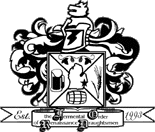 |
 |
 |
 |
 |
 |
| June 2000 | Fermental Order of Renaissance Draughtsmen | Vol. 8 No. 6 |
The next meeting will be held back at Sisko's in Taylor on Tuesday , June 27. Sisko's is located on Monroe (between Telegraph and Southfield), just south of Vanborn. Their address is 5855 Monroe and their phone number is 313-278-5340. Sisko's also has a web site at http://www.siskos.com/. The competition for this June is Competition Style. As usual, the thirsty hard-core who want dinner will start arriving around 5PM, people will drift in for an hour or so, and we will start our meeting around 6PM.
The German Lager Competition will be judged next month along with the Porter Competition.
Porter is BJCP category 15. The descriptions follow.
15. PORTER
15A. Robust Porter
Aroma: Roast malt or grain aroma, often coffee-like or chocolate-like, should be evident. Hop aroma moderate to low. Fruity esters, and diacetyl, are moderate to none.
Appearance: Dark brown to black color, may be garnet-like. Clarity may be difficult to discern in such a dark beer. Head retention should be moderate to good.
Flavor: Malt flavor usually features coffee-like or chocolate-like roasty dryness. Overall flavor may finish from medium sweet to dry, depending on grist composition, hop bittering level, and attenuation. May have a sharp character from dark roasted grains. Hop flavor varies widely. Diacetyl moderate to none.
Mouthfeel: Medium to medium-full bodied. Low to moderate carbonation.
Overall Impression: A substantial dark ale with complex roasty malt, hop and fermentation characteristics.
15B. Brown Porter
Aroma: Malt aroma with mild roastiness should be evident. Hop aroma may be moderate to low. Esters and diacetyl may be moderate to none.Appearance: Medium brown to dark brown in color. Clarity and head retention should be fair to good. Flavor: Malt flavor will include mild to moderate roastiness. Hop flavor low to none. Hop bittering will vary the balance from slightly malty to slightly bitter. Diacetyl, and sourness or sharpness from dark grains, should be low to none. Mouthfeel: Medium-light to medium bodied. Low to moderate carbonation. Overall Impression: A fairly substantial dark ale with some roasty characteristics. Comments: Softer flavors, lower gravities, and usually less alcohol than robust porter. More substance and roast than brown ale. Some versions are fermented with lager yeast.Balance tends toward malt more than hops.
Congratulations go out to David Cords who won the Belgian Beer category. Tony Tantillo came in third place in the Spice/Herb/Vegetable Beer Category
The July 26th meeting will be held at Ford Field Dearborn( Brady and Cherry Hill Rds.) picnic area # 2.
Just a reminder (can you actually forget?) that the national AHA conference is on June 22 to 24 at the Holiday Inn in Livonia, MI. Check out the web site at http://hbd.org/miy2k
For those of you bringing kegs to the conference for the hospitality suite, Chris sent the following note to the F.O.R.D. mailing list, and I thought that it would be good to repeat it here.
Phil Wilcox wrote:
Please inform all of your Club members who are bringing kegs to the Conference for the Hospitality Suite to label each keg accordingly: day, time, and Club name written on a tag or piece of masking tape attached to the top keg handle. (Example - Saturday, 10-2, F.O.R.D. Club).
Rex is anticipating at least 100 kegs, therefore they will be stacked in the reefer truck according to date and time needed. If you want to label beer style also - fine. The important thing now is knowing where to place the kegs.Bottled beers brought in cases should be labeled in the same fashion on the outside of the case. Thanx!
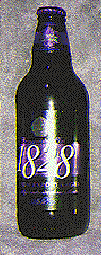
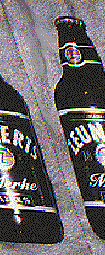 Last year, I had the opportunity to visit Gothenburg, Sweden on business. This was a unique opportunity to
sample the local tastes and even though I was only there for 2 days, we sampled several of the local favorites.
The Pripps brand appeared to be the most popular brand, and it came in several styles, from a non-alcoholic
(served in the Volvo Engineering cafeteria with lunch) to a 7% alcohol export version. I didn't take any notes
from tastings while I was there, but I did manage to sneak away long enough to visit the state-run (the only kind
allowed) liquor store. Anyone who has been to Canada would recognize this layout very similar indeed.
There was row after row of different beers. I estimate that the store had upwards of 125 different beers, quite a
difference from your local party store here in Michigan. Due to the limitations of my luggage, I was only able
to carry back 12 half-liter beers. Boy was my garment bag heavy on the long trek through Amsterdam's airport
that was required to make a connecting flight. Since I don't read Swedish, I had no idea what style the beers
were going to be, but I picked out a variety based on random factors like how cool the label was and what the
alcohol content was. So here they all are, with a few tasting notes I made while drinking these over the span of
several months. If anyone in the club can read Swedish and would like to translate the labels, I have kept the
bottles and cans and would love to know how the brewer described each
beer.
Last year, I had the opportunity to visit Gothenburg, Sweden on business. This was a unique opportunity to
sample the local tastes and even though I was only there for 2 days, we sampled several of the local favorites.
The Pripps brand appeared to be the most popular brand, and it came in several styles, from a non-alcoholic
(served in the Volvo Engineering cafeteria with lunch) to a 7% alcohol export version. I didn't take any notes
from tastings while I was there, but I did manage to sneak away long enough to visit the state-run (the only kind
allowed) liquor store. Anyone who has been to Canada would recognize this layout very similar indeed.
There was row after row of different beers. I estimate that the store had upwards of 125 different beers, quite a
difference from your local party store here in Michigan. Due to the limitations of my luggage, I was only able
to carry back 12 half-liter beers. Boy was my garment bag heavy on the long trek through Amsterdam's airport
that was required to make a connecting flight. Since I don't read Swedish, I had no idea what style the beers
were going to be, but I picked out a variety based on random factors like how cool the label was and what the
alcohol content was. So here they all are, with a few tasting notes I made while drinking these over the span of
several months. If anyone in the club can read Swedish and would like to translate the labels, I have kept the
bottles and cans and would love to know how the brewer described each
beer.
| Name | 1828 Premium Export Lager by Pripps |
| Alcohol Content | 5.0% |
| Aroma | Slightly skunked |
| Appearance | Great color deep golden. Weak head, no lace. |
| Flavor | Good hop balance. Very slightly medicinal. Probably did not travel well. |
| Body | Appropriate for style |
| Drinkability | Good balance, not too light, not too heavy. Clean finish |

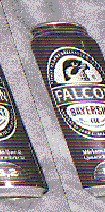
| Name | Zeunerts 1837 Merke |
| Alcohol Content | 5.3% |
| Aroma | Slightly skunky |
| Appearance | Light golden, very clear, good lace |
| Flavor | Weak on malt kind of bland like Budweiser |
| Body | Light |
| Drinkability | Definite lawnmower beer |
| Name | Gamelstadens Färsk Ol (Ale) |
| Alcohol Content | 5.0% |
| Aroma | Slightly fruity, a little yeasty due to bad pouring on my part |
| Appearance | Very pale |
| Flavor | Slightly fruity, smooth with no aftertaste. Reminds me of a Kolsch. |
| Body | No head but good carbonation, good mouthfeel |
| Drinkability | Very enjoyable! |
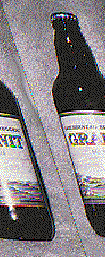
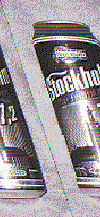
| Name | Falcon Bayerskt |
| Alcohol Content | 5.2% |
| Aroma | Slightly malty, no off aromas |
| Appearance | Medium head, deep copper color |
| Flavor | Clean bitterness dominates |
| Body | Medium to light |
| Drinkability | Good, slight lingering bitterness |
| Name | Granit Starköl |
| Alcohol Content | 4.8% |
| Aroma | Not much aroma |
| Appearance | Light ale, very little head, very clear |
| Flavor | Astringent |
| Body | Low |
| Drinkability | Not much there probably my least favorite of the ten. |
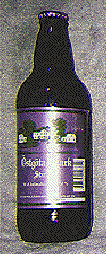

| Name | Stockholm Festival Beer |
| Alcohol Content | 7.2% |
| Aroma | Very slightly skunky |
| Appearance | Nice foamy white head, beer is very clear |
| Flavor | Dry, some alcohol bite |
| Body | Medium |
| Drinkability | Drink this one to get hammered |
| Name | Östgöta Stark |
| Alcohol Content | 5.0% |
| Aroma | Slightly sweet, almost corn-like |
| Appearance | Nice color, good carbonation, very clear |
| Flavor | Clean bitterness, no aftertaste |
| Body | Medium |
| Drinkability | Middle of the road light ale. |
| Name | Pripps Blå Klass 3 Export |
| Alcohol Content | 5.2% |
| Aroma | Subdued hop aroma dominates |
| Appearance | Golden color, no head |
| Flavor | Very smooth, nicely balanced with good hop flavor |
| Body | Full body with nice mouthfeel |
| Drinkability | My favorite of the first 8. I'd get another if I could. |


| Name | Kopparbergs Special Elk Brew |
| Alcohol Content | 5.3% |
| Aroma | Not much at all |
| Appearance | Light golden, no head |
| Flavor | Slightly fruity start, hoppy flavor finish |
| Body | Good mouthfeel with good carbonation |
| Drinkability | Good superbowl beer (I drank this one while watching the big game) |
| Name | Spendrups Old Gold |
| Alcohol Content | 5.0% |
| Aroma | Not much aroma, slightly fruity |
| Appearance | Pale golden, clear, no head |
| Flavor | Subtle flavors, clean finish |
| Body | Kind of thin |
| Drinkability | Summer beer |
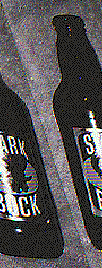
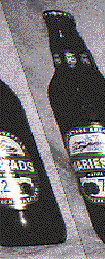
| Name | Stark Bock |
| Alcohol Content | 7.0% |
| Aroma | Slightly skunky |
| Appearance | Deep golden color, clear with little head |
| Flavor | Very smooth, balanced bitterness, slightly warming |
| Body | Big body but well balanced by the hops |
| Drinkability | Surprisingly smooth for such a big beer. Very enjoyable |
| Name | Mariestads Extra Stark |
| Alcohol Content | 7.2% |
| Aroma | Clean, nothing unusual |
| Appearance | Pale golden pretty light for such a big beer |
| Flavor | Strong up front bitterness fades to smooth finish with slight warming sensation |
| Body | Full bodied |
| Drinkability | Enjoyable, tilted towards hops |
It was very fun to sample so many different beers. I wish I had had a Swedish translator with me to help me pick out the beers since I think that most of the ones I got were light ales. I would have enjoyed tasting some more dark beers but I don't know the word for dark! I did find out later that "Stark" means "light" and "öl" means "ale". All in all, I think my favorite was the Pripps Blå Klass 3 export with the Stark Bock a close second. Hope you enjoyed these Twelve Swedish Beauties!
All of the following articles are taken from the Real Beer Page Monthly Brew News Digest...
Dutch brewer Heineken has acquired a 50% stake of Belgian brewer Affligem Brouwerij (formerly Brouwerij De Smedt). The Affligem lineup includes several beers that are sent to the United States, including a dubel, a tripel and the popular holiday seasonal, Affligem Noel. The brewery mainly produces abbey-style beers for the Affligem Abbey. The abbey first brewed beer in the 11th century. Since 1980, Heineken has marketed and distributed the beer to The Netherlands and France. Heineken also has a license agreement with the abbey for the rest of the world. The license for Belgium and Luxembourg remains with the Affligem Brewery.
A new study published in the British Medical Journal contends that drinking a pint of beer every day can reduce the risk of heart attacks. A study of Czech men found that those who drank up to two pints of beer a day had the lowest risk of coronary heart disease. The men were chosen because they predominately drank beer and rarely drank wine or spirits. The lowest risk of heart disease was among men who drank daily and drank between four to nine liters (eight to 16 pints) of beer a week. Drinking large amounts of beer led to a loss of the protective effects of alcohol.
John Palmer has written some of the most read documents on homebrewing available on the Internet. He's put his accumulated knowledge in book form - and the whole thing is available on the Web. He's got tips for everybody from the first-time brewer to the most seasoned veteran. Check it out at: http://www.howtobrew.com
American Beer Month will kick off in a big way July 1, with a Brewers Rally in Philadelphia and major festivals in Colorado and Florida. Just as important, you will be able to celebrate the tradition and innovation of American brewing at the Michigan Brewers Guild Summer Festival held on July 22nd at Greenmead in Livonia. More information about the American Beer Month can be found at: http://www.realbeer.com/spotlight/abm
Sleeman Breweries of Canada and the Boston Beer Co. of the United States -- the two largest craft breweries in their respective countries -- have entered into a two-way agreement intended to make the beers of both breweries more widely available in North America. As part of the strategic partnership, Sleeman will immediately begin representation of Samuel Adams products in several key markets in Canada. Boston Beer will conduct market research in the United States to identify potential markets for Sleeman brand products and assist Sleeman with brand development and selling strategies if sufficient market potential is identified.
Paulaner North America apparently has lost its long-running battle with the state of Ohio over the label for Mannekin Pis, a beer that PNA imports from Belgium. The beer's label features the famous bronze statue of a small naked small boy urinating. Ohio officials first called the label "offensive and in poor taste" and banned Paulaner from shipping the beer into the state. PNA lost its latest round in appeals court when the court agreed that government can't legislate taste, but upheld the ban based on an Ohio law that forbids the portrayal of children on beer bottles.
Let's call it the "Milwaukee Paradox."....Although studies of the French's paradoxically healthy hearts are still ongoing researchers later said that other alcoholic drinks were also beneficial because they can help increase the amount of high-density lipoprotein, known as the good cholesterol... Because it is made with yeast and grains, beer is a good source of folate and vitamin B6, which have been shown to help reduce the amount of the chemical homocysteine in the blood. High homocysteine concentrations are known risks for heart disease...the [Dutch] researchers tested beer's possible superiority by having 11 healthy men drink controlled amounts of beer, wine, gin or water for three weeks so that each received the same amount of alcohol. The rest of their diet was identical. The researchers found that water had no effect on the men while wine and gin raised homocysteine levels 8 and 9percent...But beer prompted no change in homocysteine, and it raised levels of vitamin B6 by 30%.
July's competition is the venerable pale ale category. Since ordinary and best bitter has its own category we will limit the entries to BJCP category 4C (Strong Bitter/English Pale Ale), 6A (American Pale Ale), 6B (American Amber Ale), 6c (California Common) and 7 (India Pale Ale). I included category 6B since this was split off of the American Pale Ale category fairly recently (vide infra. The inclusion of California Common is strange, but the BJCP considers it port of the American Pale Ale category (6).
Aroma: Hop aroma high to none. Diacetyl and caramel aroma moderate to none. Moderate fruitiness. Malt aroma apparent.
Appearance: Copper to dark amber-brown. May have very little head.
Flavor: Malt flavors evident. Crystal malt flavor common. Hop flavor ranges from low to strong. Diacetyl and fruitiness moderate to none. Balance varies from even to quite bitter, although malt flavor should not be completely overpowered.
Mouthfeel: Medium to medium-full body. Carbonation low, although bottled pale ales tend to have moderate carbonation. Warming from alcohol may be noticeable, but should not be strong.
Overall Impression: A solidly flavored beer both in terms of malt and hops. More evident malt and hop flavors than in a special bitter.
Aroma: Usually moderate to strong hop aroma from dry hopping or late kettle additions of American hop varieties. Citrusy hop aroma very common. Esters vary from low to high. Diacetyl moderate to none.
Appearance:Pale golden to amber.
Flavor: Often moderate to high hop flavor. Citrusy hop flavor very common (such as from Cascades), but also other American hop variety flavors are found. Malt flavor moderate relative to aggressive hop flavor and bitterness. Balance towards bitterness. Caramel flavor is usually restrained. Diacetyl moderate to none.
Mouthfeel: Many are rather light, refreshing and more highly carbonated than many other styles, but body can reach medium. Carbonation borders on effervescent in some examples.
Overall Impression: Should be refreshing.
Comments: In the past, this category also covered what is now called American amber ale. American pale ales differ from American amber ales notably by being lighter in color, but also in having less caramel flavor and usually being balanced more towards hop bitterness.
Aroma: Often a mild to strong hop aroma from dry hopping or late kettle additions of American hop varieties. Some caramel aroma common. Esters vary from low to high. Diacetyl medium-high to none.
Appearance: Light copper to light brown.
Flavor: Moderate to high hop flavor from American hop varieties. Malt/bitterness balance can be on either side of even and is more likely to be on the malt side, but usually not too far from center. Caramel flavor is moderate to strong. Diacetyl medium-high to none.
Mouthfeel: Body is medium to medium-full. Carbonation typically moderate.
Overall Impression: Caramel usually balances the bitterness.
Comments: In the past, this category used to be part of American pale ale. American amber ales differ from American pale ales not only by being darker in color, but also in having more caramel flavor and usually being balanced more evenly even between malt and bitterness.
Aroma: May have a pronounced woody or rustic hop aroma (as from Northern Brewer, for example). Restrained fruitiness. May have a moderate toasted malt aroma. Diacetyl low to none.
Appearance: Dark gold to copper to medium amber.
Flavor: Malty, balanced with a pronounced hop bitterness. Rustic/woody (e.g., Northern Brewer) hop flavor medium to none. May have a toasted (not roasted) malt flavor. Balance is generally about even between malt and hops. Diacetyl low to none.
Mouthfeel: Medium-bodied. Medium to medium-high carbonation.
Overall Impression: A beer with solid malt and hop expression, only mildly fruity and having woody/rustic hop character.
Comments: Similar to American pale ale, although typically less fruity. Hop flavor/aroma is woody rather than citrusy, although a slightly citrusy character has been noted by some in a commercial example back in the mid-1980s.
Aroma: A prominent hop aroma of floral, grassy, or fruity characteristic typical. A caramel-like or toasty malt presence may also be noted, but may be at a low level. Fruitiness, either from esters or hops, may also be detected.
Appearance: Color ranges from medium gold to deep copper, with English versions often darker than American ones. Should be clear, although some haze at cold temperatures is acceptable.
Flavor: Hop flavor is medium to high, with an assertive hop bitterness. Malt flavor should be low to medium, but should be sufficient to support the hop aspect. Despite the substantial hop character typical of these beers, sufficient malt flavor, body and complexity to support the hops will provide the best balance. Very low levels of diacetyl are acceptable, and fruitiness from the fermentation or hops should add to the overall complexity. Some alcohol warming may be sensed in stronger versions.
Mouthfeel: Smooth, medium-bodied mouthfeel without astringency, although it has moderate carbonation combine to render an overall dry sensation in the presence of malt sweetness.
Overall Impression: A decidedly hoppy, moderately strong pale ale.
Commercial Examples: Anchor Liberty Ale, Sierra Nevada Celebration Ale, Brooklyn East India Pale Ale, Tupper's Hop Pocket, Great Lakes Commodore Perry IPA, Samuel Smith's India Ale, Fuller's IPA, Highfalls IPA, Victory Hopdevil, Three Floyds Alpha King.
| Beer Events, Meetings & Competitions
Gabrielle Palmer |
 |
| Fermental Funny |

| Ye Olde Brew News
published by the F.O.R.D. Homebrew Club |
|
| Editor:
Tony Tantillo Contributors:
Club Officers:
|
F.O.R.D. is a private, non-profit organization of homebrewers. The main goal of this club is to
promote awareness and appreciation of the quality and variety of beer; to share information regarding technique, equipment and skill
required to brew quality homemade beer; and to encourage responsible use of beer as an alcohol-containing beverage.
Correspondence should be directed to:
Phone: 810-795-0512
Visit our website at: http://www.be.ford.com/brewers/
current circulation... 125 |